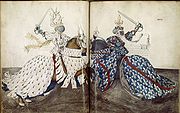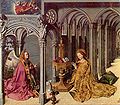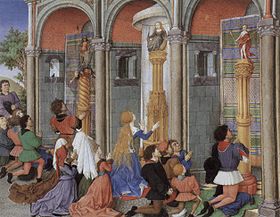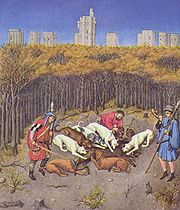
Barthélemy d'Eyck
Encyclopedia


France
The French Republic , The French Republic , The French Republic , (commonly known as France , is a unitary semi-presidential republic in Western Europe with several overseas territories and islands located on other continents and in the Indian, Pacific, and Atlantic oceans. Metropolitan France...
and probably in Burgundy
Duchy of Burgundy
The Duchy of Burgundy , was heir to an ancient and prestigious reputation and a large division of the lands of the Second Kingdom of Burgundy and in its own right was one of the geographically larger ducal territories in the emergence of Early Modern Europe from Medieval Europe.Even in that...
as a painter and manuscript illuminator. He was active between about 1440 to about 1469.
Although no surviving works can be certainly documented as his, he was praised by contemporary authors as a leading artist of the day, and a number of important works are generally accepted as his. In particular, Barthélemy has been accepted by most experts as the identity of the artists formerly known as the Master of the Aix Annunciation for paintings, and the Master of René of Anjou for illuminated manuscript
Illuminated manuscript
An illuminated manuscript is a manuscript in which the text is supplemented by the addition of decoration, such as decorated initials, borders and miniature illustrations...
s. He is thought by many to be the Master of the Shadows responsible for parts of the calendar of the Très Riches Heures du Duc de Berry
Très Riches Heures du Duc de Berry
The Très Riches Heures du Duc de Berry or simply the Très Riches Heures is a richly decorated book of hours commissioned by John, Duke of Berry, around 1410...
.
Biography
It is likely that he was related to Jan van EyckJan van Eyck
Jan van Eyck was a Flemish painter active in Bruges and considered one of the best Northern European painters of the 15th century....
but this cannot be documented. His stepfather was a cloth-merchant who followed René of Anjou to Naples
Naples
Naples is a city in Southern Italy, situated on the country's west coast by the Gulf of Naples. Lying between two notable volcanic regions, Mount Vesuvius and the Phlegraean Fields, it is the capital of the region of Campania and of the province of Naples...
and the South of France. His mother died in 1460, and was described as "Ydria Exters d'Allemagne" - that is "of Germany", which might well have included all the Netherlands as far as the Provencals were concerned. Jan van Eyck's brother, Lambert, seems also to have worked in Provence after Jan's death.
Some authorities have proposed, on stylistic grounds as well as the likely family relationship, that Barthélemy trained in the workshop of Jan van Eyck, and worked in the 1430s on the Milan-Turin Hours, a famous illuminated manuscript, much of which only survives in black-and-white photographs after its destruction in a fire. A painter called only "Barthélemy" is documented as working in Dijon
Dijon
Dijon is a city in eastern France, the capital of the Côte-d'Or département and of the Burgundy region.Dijon is the historical capital of the region of Burgundy. Population : 151,576 within the city limits; 250,516 for the greater Dijon area....
for Philip the Good, Duke of Burgundy
Duke of Burgundy
Duke of Burgundy was a title borne by the rulers of the Duchy of Burgundy, a small portion of traditional lands of Burgundians west of river Saône which in 843 was allotted to Charles the Bald's kingdom of West Franks...
in 1440; this may well be him. René of Anjou, who was to become Barthélemy's major patron, had been held prisoner there by Philip. By 1444 Barthélemy d'Eyck was in Aix-en-Provence
Aix-en-Provence
Aix , or Aix-en-Provence to distinguish it from other cities built over hot springs, is a city-commune in southern France, some north of Marseille. It is in the region of Provence-Alpes-Côte d'Azur, in the département of Bouches-du-Rhône, of which it is a subprefecture. The population of Aix is...
in the South of France presumably working with the leading French painter Enguerrand Quarton
Enguerrand Quarton
Enguerrand Quarton was a French painter and manuscript illuminator whose few surviving works are among the first masterpieces of a distinctively French style, very different from either Italian or Early Netherlandish painting...
as they witnessed a legal document together.

Aix Annunciation
The Aix Annunciation is a painting attributed to the Barthélemy d'Eyck or the so-called Master of the Annunciation of Aix-en-Provance. Executed in 1443-1445, it was originally placed in the church of Saint-Sauveur, Aix-en-Provence, southern France...
, dating from 1443–1445, is now generally accepted as being by Barthélemy. It is a triptych
Triptych
A triptych , from tri-= "three" + ptysso= "to fold") is a work of art which is divided into three sections, or three carved panels which are hinged together and can be folded shut or displayed open. It is therefore a type of polyptych, the term for all multi-panel works...
, now dispersed between Aix-en-Provence, Brussels, Amsterdam and Rotterdam (one of the side-panels having been cut into two pieces). It was commissioned by a cloth-merchant who knew Barthélemy's stepfather, and combines influences from the Early Netherlandish art of Robert Campin
Robert Campin
Robert Campin , now usually identified as the artist known as the Master of Flémalle, is usually considered the first great master of Early Netherlandish painting...
and Jan van Eyck
Jan van Eyck
Jan van Eyck was a Flemish painter active in Bruges and considered one of the best Northern European painters of the 15th century....
with those of Claus Sluter
Claus Sluter
Claus Sluter was a sculptor of Dutch origin. He was the most important northern European sculptor of his age and is considered a pioneer of the "northern realism" of the Early Netherlandish painting that came into full flower with the work of Jan van Eyck and others in the next generation.Sluter...
who worked at Dijon, and Colantonio from Naples (although some see this last influence as flowing in the other direction). Many of the iconographic details follow those from Annunciations by Jan van Eyck and his circle, such as the Washington Annunciation
Annunciation (van Eyck, Washington)
The Annunciation is an oil painting by the Early Netherlandish master Jan van Eyck, from around 1434-1436. It is in the National Gallery of Art, in Washington D.C. It was originally on panel but has been transferred to canvas. It is thought that it was the left wing of a triptych; there has...
. Together with a fine portrait dated 1456 (Lichtenstein Collection, Vienna), and a fragment with a small crucified Christ in the Louvre
Louvre
The Musée du Louvre – in English, the Louvre Museum or simply the Louvre – is one of the world's largest museums, the most visited art museum in the world and a historic monument. A central landmark of Paris, it is located on the Right Bank of the Seine in the 1st arrondissement...
, this is the only surviving panel painting
Panel painting
A panel painting is a painting made on a flat panel made of wood, either a single piece, or a number of pieces joined together. Until canvas became the more popular support medium in the 16th century, it was the normal form of support for a painting not on a wall or vellum, which was used for...
associated with him; most of his later works are illuminated manuscript
Illuminated manuscript
An illuminated manuscript is a manuscript in which the text is supplemented by the addition of decoration, such as decorated initials, borders and miniature illustrations...
s commissioned by René of Anjou.
René of Anjou was a prince of the Valois family who had a complicated range of titles and claims, including that of King of Naples, from which kingdom he was ejected by the House of Aragon
House of Aragon
The House of Aragon is the name given several royal houses that ruled the County, the Kingdom or the Crown of Aragon.Some historiansGuillermo Fatás y Guillermo Redondo, Alberto Montaner Frutos, Faustino Menéndez Pidal de Navascués...
by 1442. There is evidence that Barthélemy either went to Naples, or that his works were known there, as his influence has been detected in the work of the Neapolitan artists Colantonio and Antonello da Messina
Antonello da Messina
Antonello da Messina, properly Antonello di Giovanni di Antonio was an Italian painter from Messina, Sicily, active during the Italian Renaissance...
. René preferred to live in his territories in the South of France, or in the Loire Valley
Loire Valley
The Loire Valley , spanning , is located in the middle stretch of the Loire River in central France. Its area comprises approximately . It is referred to as the Cradle of the French Language, and the Garden of France due to the abundance of vineyards, fruit orchards, and artichoke, asparagus, and...
, and was a poet and amateur artist of some talent. For a long time he was thought personally responsible for the manuscript illuminations now generally attributed to Barthélemy. From about 1447 Barthélemy appears in surviving accounts as "peintre et varlet de chambre" - the same positions as Jan van Eyck held with Philip the Bold (and the Limbourg brothers
Limbourg brothers
The Limbourg brothers, or in Dutch Gebroeders van Limburg , were famous Dutch miniature painters from the city of Nijmegen. They were active in the early 15th century in France and Burgundy, working in the style known as International Gothic...
had held with the Duke of Berry
Duke of Berry
The title of Duke of Berry in the French nobility was frequently created for junior members of the French royal family. The Berry region now consists of the départements of Cher, Indre and parts of Vienne. The capital of Berry is Bourges. The first creation was for John, third son of John II, King...
). A "varlet de chambre" was a court appointment of considerable status as a personal attendant to René. He travelled with René to Guyenne
Guyenne
Guyenne or Guienne , , ; Occitan Guiana ) is a vaguely defined historic region of south-western France. The Province of Guyenne, sometimes called the Province of Guyenne and Gascony, was a large province of pre-revolutionary France....
and on several occasions to Angers
Angers
Angers is the main city in the Maine-et-Loire department in western France about south-west of Paris. Angers is located in the French region known by its pre-revolutionary, provincial name, Anjou, and its inhabitants are called Angevins....
. Between 1447 and 1449 his workroom was next to René's private apartments, suggesting a considerable and unusual degree of closeness to his patron. His last appearance in the accounts is in 1469, when he was paid his own salary, plus that of three servants or assistants, and three horses. There is some evidence he lived until 1476.
Manuscripts

Book of Hours
The book of hours was a devotional book popular in the later Middle Ages. It is the most common type of surviving medieval illuminated manuscript. Like every manuscript, each manuscript book of hours is unique in one way or another, but most contain a similar collection of texts, prayers and...
in the Morgan Library
Morgan Library
The Morgan Library & Museum is a museum and research library in New York City, USA. It was founded to house the private library of J. P. Morgan in 1906, which included, besides the manuscripts and printed books, some of them in rare bindings, his collection of prints and drawings...
in New York, on which Quarton also worked, and five miniatures
Miniature (illuminated manuscript)
The word miniature, derived from the Latin minium, red lead, is a picture in an ancient or medieval illuminated manuscript; the simple decoration of the early codices having been miniated or delineated with that pigment...
added to The London Hours of René of Anjou in the British Library
British Library
The British Library is the national library of the United Kingdom, and is the world's largest library in terms of total number of items. The library is a major research library, holding over 150 million items from every country in the world, in virtually all known languages and in many formats,...
which relate very personally and intensely to René's unhappy situation whilst imprisoned in Dijon. Harthan suggests the designs for these may have been sketched by René himself for Barthélemy to execute: "the faithful interpreter of the King's exalted ideas, an inseparable, discreet companion and the effective partner, perhaps, in joint artistic enterprises" http://www.bl.uk/catalogues/illuminatedmanuscripts/TourPopup.asp?TourID=159.
The two best-known manuscripts are the Livre du cueur d'amour esprit and the Théséide, both in Vienna (Österreichische Nationalbibliothek, Codex
Codex
A codex is a book in the format used for modern books, with multiple quires or gatherings typically bound together and given a cover.Developed by the Romans from wooden writing tablets, its gradual replacement...
2597, 2617), dating from 1460–70, with sixteen and seven miniatures respectively. The Livre du cueur d'amour esprit was a courtly allegorical romance written (almost certainly) by René. This has spaces reserved for a further twenty-nine miniatures, and these are all completed in another manuscript by a much less brilliant artist, probably working from Barthélemy's drawings. This chivalric
Chivalry
Chivalry is a term related to the medieval institution of knighthood which has an aristocratic military origin of individual training and service to others. Chivalry was also the term used to refer to a group of mounted men-at-arms as well as to martial valour...
allegorical
Allegory
Allegory is a demonstrative form of representation explaining meaning other than the words that are spoken. Allegory communicates its message by means of symbolic figures, actions or symbolic representation...
romance comes near the end of that tradition, and only allows Barthélemy's realism and human sympathy to be engaged in places. His exceptional skill at lighting effects is fully deployed; four of the sixteen miniatures are night scenes, and others show dawn or dusk with great brilliance. The larger and more populated scenes of the French translation of Boccaccio
Giovanni Boccaccio
Giovanni Boccaccio was an Italian author and poet, a friend, student, and correspondent of Petrarch, an important Renaissance humanist and the author of a number of notable works including the Decameron, On Famous Women, and his poetry in the Italian vernacular...
's Il Teseida delle nozze d'Emilia, in theory about Theseus
Theseus
For other uses, see Theseus Theseus was the mythical founder-king of Athens, son of Aethra, and fathered by Aegeus and Poseidon, both of whom Aethra had slept with in one night. Theseus was a founder-hero, like Perseus, Cadmus, or Heracles, all of whom battled and overcame foes that were...
, in practice another romance, include magnificent scenes of urban life.

King René's Tournament Book
Le Livre des tournois by René d'Anjou of ca. 1460 describes rules of a tournament....
(BnF Ms Fr 2695) which is unusual in being in watercolour, rather than tempera
Tempera
Tempera, also known as egg tempera, is a permanent fast-drying painting medium consisting of colored pigment mixed with a water-soluble binder medium . Tempera also refers to the paintings done in this medium. Tempera paintings are very long lasting, and examples from the 1st centuries AD still exist...
and on paper
Paper
Paper is a thin material mainly used for writing upon, printing upon, drawing or for packaging. It is produced by pressing together moist fibers, typically cellulose pulp derived from wood, rags or grasses, and drying them into flexible sheets....
rather than vellum
Vellum
Vellum is mammal skin prepared for writing or printing on, to produce single pages, scrolls, codices or books. It is generally smooth and durable, although there are great variations depending on preparation, the quality of the skin and the type of animal used...
.
He is also believed by many art historians to be the Master of the Shadows who added to the illustration of the Très Riches Heures du Duc de Berry
Très Riches Heures du Duc de Berry
The Très Riches Heures du Duc de Berry or simply the Très Riches Heures is a richly decorated book of hours commissioned by John, Duke of Berry, around 1410...
in the mid 15th century, long after the Limbourg brothers
Limbourg brothers
The Limbourg brothers, or in Dutch Gebroeders van Limburg , were famous Dutch miniature painters from the city of Nijmegen. They were active in the early 15th century in France and Burgundy, working in the style known as International Gothic...
had produced the most famous miniatures (they and the Duke died in 1416, leaving the manuscript unfinished and unbound). By then the book may have belonged to René. The calendar scene for September, probably only partly by this master, shows the chateau at Saumur
Saumur
Saumur is a commune in the Maine-et-Loire department in western France.The historic town is located between the Loire and Thouet rivers, and is surrounded by the vineyards of Saumur itself, Chinon, Bourgueil, Coteaux du Layon, etc...
, which René owned, and where he spent much of the 1460s. He also painted the main calendar scenes for March (perhaps only in part), October and December. His spatial awareness was greater than that of the Limbourgs, and he included shadows, which are a very marked feature of the miniatures of Barthélemy. His faces, especially those of peasants, are more sharply individualised, although his figures are less elegant. Only these calendar scenes, and possibly the faces in the double-page Procession of St Gregory (Walther & Wolf, op cit), show his style; many other miniatures were added a generation later by Jean Colombe
Jean Colombe
Jean Colombe was a French miniature painter and illuminator of manuscripts. He is best known for his work in Très Riches Heures du Duc de Berry...
.

